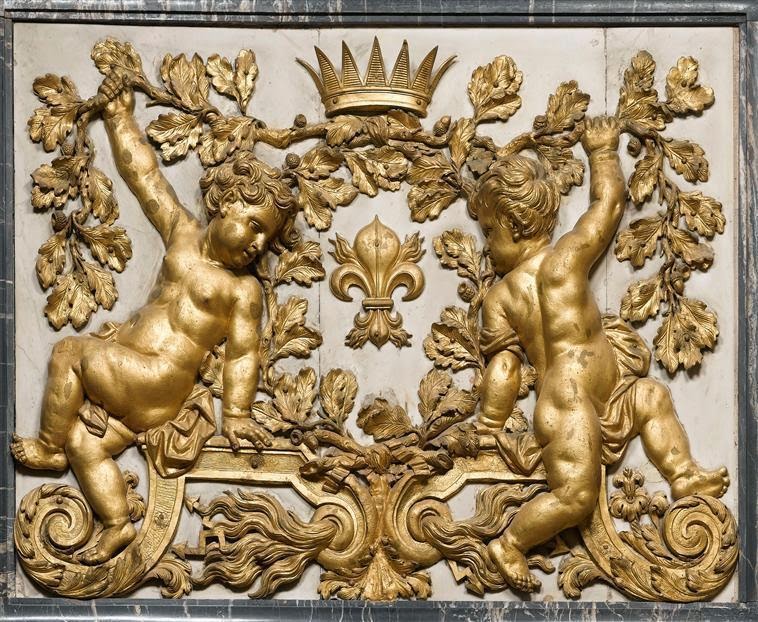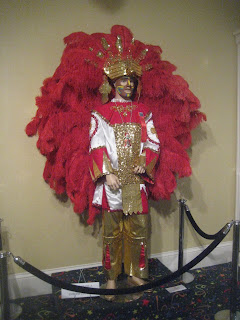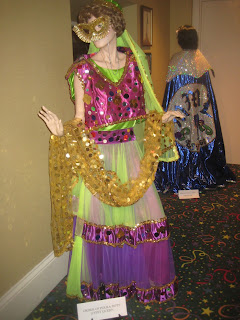A Mobile Mardi Gras King's crown
This is part 3 the last of a three part series exploring The Mobile Carnival Museum a wonderful museum located in a Historic Mansion in Mobile, Alabama . The staff are warm and friendly. You can take all of the photo's you like in the Museum. I highly recommend this museum if you are visiting Mobile, Alabama.
The Museum is located in the historic Bernstein-Bush mansion built in 1872 for Henry Bernstein, a boot and shoe dealer. The mansion was designed by architect James H. Hutchisson in the mixed style of Italianate and Greek Revival styles. The interiors of this house is particularly fine detail of beautifully cast plaster details and Mid 19th century Gasoliers original from fine mansions torn down on the next block in the 1960's. The gasoliers were moved to this house. The home is registered as a historic building. The accumulation of royal robes, crowns and scepters is beautifully displayed throughout the museum.
The terms "Mardi Gras" (pronounced /ˈmɑrdiɡrɑː/), "Mardi Gras season", and "Carnival season",in English, refer to events of the Carnival celebrations, beginning on or after Epiphany and ending on the day before Ash Wednesday. Mardi Gras is French for "Fat Tuesday" (in ethnic English tradition, Shrove Tuesday), referring to the practice of the last night of eating richer, fatty foods before the ritual fasting of the Lenten season, which started on Ash Wednesday.
While not observed nationally throughout the United States, a number of traditionally ethnic French cities and regions in the country have notable celebrations. Mardi Gras arrived in North America as a French Catholic tradition
Bienville found the settlement of Mobile, Alabama in 1702 as the first capital of French Louisiana. In 1703 French settlers in Mobile began the Mardi Gras celebration tradition. Mobile is known for having the oldest organized carnival celebrations in the United States, dating to the 18th century of its early colonial period. It was also host to the first formally organized Carnival mystic society or "krewe" in the United States, dating to 1830.
Mobile Mardi Gras King and Queen
trains and lavish costumes of the Mardi Gras royalty
A Mobile Mardi Gras King's & Queens
trains and lavish costumes of the Mardi Gras royalty
Throughout his career, Lagman performed for hundreds of parties, schools, organizations and civic events including America's Junior Miss. He wrote special arrangements for many Carnival societies' tableau and his orchestra was always in demand during Mardi Gras for fifty years. He is an important part of Mobile's musical history playing Ragtime in the twenties and Big Band music from the thirties through the seventies. One of Bill's original trumpets is on display at the Mobile Carnival Museum and the trumpet given to him by The Tonight Show band leader Doc Severinsen, is on display at the Museum of Mobile.
He was awarded the M.O. Beale Scroll of Merit in 1968 for his “artistic contribution to [Mobile's] social and civic life.” Lagman was one of the founders of the Mobile Jazz Festival. He was named “Mr. Music” by the Mobile Jazz Festival in 1968 , and in 2002 the Tricentennial Jazz Festival was dedicated to his memory.
He wrote and arranged music for his bands to perform. Lagman wrote the words and music to “Alpha Delta Kappa Sweetheart” and dedicated it to his wife, Claire. The song entitled “Mobile's Azalea Trail” promoted the city and its beauty. It was performed by Rudy Vallee on his Standard Brands radio program. Lagman was the director of the choir at St. Mary's Church. He left the score of “Holy, Holy, Holy” which he was composing for the Easter liturgy on his piano when he died on January 10, 1976.
The Excelsior Band has a very rich history. It was founded by John A. Pope to celebrate the birth of his son, John C. Pope in Mobile, AL on November 23, 1883.
The Excelsior Band has marched the streets of downtown Mobile for over 100 years in various Mardi Gras parades. Additionally, The band, which plays Dixieland and conventional jazz, is available for weddings, receptions, jazz funerals, conventions, and parades.
The band performs regularly along the Gulf Coast and is recognized for providing the unique sounds associated with the carnival season in Mobile, AL, the birthplace of Mardi Gras in the United States.
The Excelsior Band is a ten piece marching brass band that consists of three trumpets, three saxophones, one trombone, a tuba, bass drum and snare drum. The group also performs as a quintet, as requested for smaller events, e.g. birthday parties, wedding receptions, conventions. The Members of the Excelsior Band come from diverse occupational background and all are highly touted in the Mobile area for their many years of musical contributions throughout the city.
The musical hodge-podge that makes up the Excelsior medley floats in the swing of Carnival cheer with such favorites as “Margie”, “Hello Dolly”, “St. Louis Blues”, “South Rampart Street Parade”, and, of course, “When the Saints Go Marching In.”
Black Mardi Gras King
trains and lavish costumes of the Mardi Gras royalty
trains and lavish costumes of the Mardi Gras royalty
One of the original Renaissance Revival marble mantels in the Bernstein-Bush mansion built in 1872
One of the original Renaissance Revival marble mantels in the Bernstein-Bush mansion built in 1872
Hand carved table 1849 carved with the Strikers goats and dauphin base is one of the oldist Mardi Gras relics around
The Strikers Independent Society hand carved table 1849. The Strikers Independent Society (S. I. S.) is a mystic society founded in 1843 [1] in Mobile, Alabama (during Mobile's first American period) and participated in Carnival during New Year's Eve and New Year's Day celebrations. It is the oldest remaining mystic society in America but no longer hosts an annual parade.
The Strikers Independent Society was formed initially by young men in Mobile who had been refused membership to the older Cowbellion de Rakin Society (which had been formed in year 1830 by "more sedate and astute men of the city"). In the beginning, it was designated as a bachelor-only society, and if a member married, then they were out of the society. The Strikers, like the Cowbellions, paraded only on New Year's Eve and held their ball on New Year's Day.
Hand carved table 1849 carved with the Strikers goats and dauphin base is one of the oldist Mardi Gras relics around
Hand carved table circa 1849 the table top carved with work symbols of the members of the Strikers
Hand carved table 1849 carved with the Strikers goats and dauphin base is one of the oldist Mardi Gras relics around
A case of Mobile Mardi Gras Silver
Everywhere visitors turn, they see reminders of the royal lineage, the litany of familiar names and multiple generations of blueblood Mobilians who passed along birthrights to not only symbolic rule, but also more de facto versions. It brings to mind an old joke about the "problem with Mobile" being that "half the people think the King and Queen of Mardi Gras are real and the other half wish they were." – Kevin Lee, Lagniappe, 7/5/2006
Joe Cain as Slackabamarinico & one of his Merry Widows
Joe Cain (1832-1904) is regarded as the founder of Mobile's modern-day Mardi Gras celebration. In 1866, Cain paraded through downtown Mobile dressed as an Indian chief, an act that helped rejuvenate the city's carnival tradition after the Civil War. Today, revelers commemorate Cain's role in reviving the celebration with a large public parade first held in the early 1960s.
Joseph Stillwell Cain was born in Mobile, Mobile County, on October 10, 1832. His parents had moved to Mobile from Philadelphia, Pennsylvania, in 1825. From an early age, Cain was enamored of the various social clubs and societies in the city. At 13, he was a charter member of the Tea Drinkers Society (TDS), a social club that paraded on New Year's Eve with other such social clubs, known as mystic societies. Before the outbreak of the Civil War, Mardi Gras was celebrated in conjunction with festivities to ring in the New Year.
The beginning of the Civil War ended these celebrations as a blockade strangled off trade in Mobile. In April 1865, Union troops took control of the city. Like many young Alabamians, Cain fought in the war, serving as a private in the Confederate Army until 1864. After his service ended, he lived briefly in New Orleans, where he participated in that city's Mardi Gras festivities.
In 1866, Cain returned to Mobile and decided to revive the spirit of Mobile's New Year's Eve festivities during the more traditional pre-Lenten period observed in New Orleans. In 1866, Cain and six original members of TDS rode through Mobile's streets in a decorated charcoal The members of the troupe dressed in exaggerated Indian attire, and Cain led the impromptu parade dressed as a fictional Chickasaw chieftain named Slackabamarinico. Along their route, Cain exuberantly declared an end to Mobile's suffering and signaled the return of the city's parading activities, to the delight of local residents. His actions also succeeded in moving Mobile's celebration to the traditional Fat Tuesday. In 1867, Cain led a parade of 16 former Confederate soldiers who called themselves the Lost Cause Minstrels. Because of this troupe, the mythology of the Lost Cause would become a central part of Mobile's Mardi Gras festivities for many years thereafter. Cain was one of the founding members of the Order of Myths, and the society's emblem, Folly chasing Death around a broken column, is seen by many as another invocation of the mythology of the Lost Cause.
Cain worked in various jobs in Mobile throughout his life. Soon after the war, he returned to his position as a cotton broker. But the post-war cotton market was never as prosperous as it was during the antebellum period, and Cain, like many others, soon moved on to other professions. He served as a volunteer fireman and briefly worked in the Mobile coroner's office. During his later years, Cain worked as a clerk at Mobile's Southern Market, a large produce and meat market located on the ground floor of the stately City Hall, a building that now houses the Museum of Mobile. Later in his life, he and his wife moved to Bayou la Batre to live with his son. Cain's resurrection of Mobile's season of revelry was widely admired, and he remained a favorite at local festivities for the rest of his life. Cain died on April 17, 1904, and was buried in Oddfellow's Cemetery, outside Bayou La Batre.
Joe Cain in 1866
Mobile native Joe Cain is credited with reviving the city's Mardi Gras tradition. In 1865, soon after the end of the Civil War, he and a group of friends led a parade through the city's downtown. He is honored by Mardi Gras revelers every year in a ceremony held at his grave in the historic Church Street Graveyard.
A beautiful Mobile Mardi Gras Ball dress from the year I was born
A beautiful Mobile Mardi Gras Ball dress from the year I was born
A beautiful Mobile Mardi Gras Ball dress
A Mobile Mardi Costume
A Mobile Mardi Costume
A Mobile Mardi Costume





















































Mr. Cain was an interesting fellow! I wonder how he felt on that first march after the war? Was he nervous?
ReplyDeleteI am inspired to make a bed canopy similar to the trains on the Mardi Gras gowns. It should take me 10 years or so!
Hi Divine Theatre I'm sure Joe was just fine. The South was a sad place after the war and he just wanted Mobile to get back to the fun and merriment of the past. It should not take that long the original trains and gowns take about a years to make.
ReplyDelete